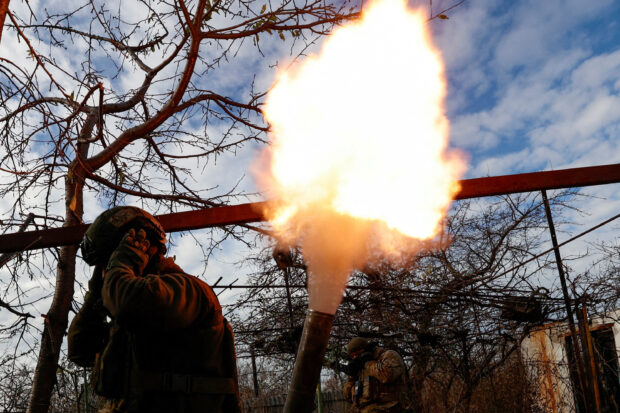
\Members of Ukraine’s National Guard Omega Special Purpose unit fire a mortar toward Russian troops in the front line town of Avdiivka, amid Russia’s attack on Ukraine, in Donetsk region, Ukraine November 8, 2023. Radio Free Europe/Radio Liberty/Serhii Nuzhnenko via REUTERS/File Photo
KYIV — Oleksii Tilnenko hoped this would be the year Ukraine drove Russian forces out of swathes of occupied land. As 2023 draws to a close, his southern hometown of Kherson is still being pounded by shelling and the front line has barely budged.
Tilnenko, who fled Kherson last year and lives in Kyiv where he helps internally displaced people (IDPs), believes Russia is racing to rebuild its much larger armed forces to step up its war effort.
“The hope is the West can somehow mobilize, somehow fire up its defense industry to renew equipment and produce what’s needed to defend our ordinary citizens,” said the 36-year-old.
More than 21 months into the biggest conflict in Europe since World War Two, fighting rages with no end in sight and neither side has landed a telling blow on the battlefield.
Ukrainian soldiers, living in freezing trenches, acknowledge they are exhausted going into a second winter of full-scale war with a resource-rich, nuclear-armed superpower that has more than triple Ukraine’s population.
Ukrainians know they must secure Western military aid to carry on – and that it will be harder with the Israel-Hamas war in Gaza distracting global attention.
Russian troops, who occupy about 17.5% of Ukraine, are again on the offensive in the east after largely withstanding a Ukrainian counteroffensive that was unable to punch through sprawling defensive lines in the south and east.
The darkening outlook contrasts starkly with Kyiv’s buoyant mood a year ago, after Ukrainians defied expectations by beating back Russian troops around their capital before recapturing territory in the northeast and south, including Kherson city.
Why it matters
The toll keeps mounting in a war that has already killed or wounded hundreds of thousands of people, destroyed Ukrainian cities, towns and villages, forced millions from their homes and placed hundreds of thousands more under occupation.
Drone and missile strikes are a part of daily life. In the northeastern city of Kharkiv, schools are being built underground so children can study in classrooms without dying in an air strike.
Tilnenko heads Crimea SOS, a group that helps Ukraine’s 5 million IDPs. He says he has no plans to return to Kherson because of the constant threat from artillery and guided aerial bombs.
He feels Western military aid should have come faster, in larger volumes and in a less piecemeal fashion. Air power vital for the counteroffensive, he says, was sorely lacking this year and promised F-16 fighter jets have not been delivered.
The passage of vital military and financial assistance from the West is no longer happening smoothly.
U.S. President Joe Biden has made a Ukrainian victory a foreign policy goal as he campaigns for re-election in November 2024, but the fate of a $60 billion aid package proposed by Biden is uncertain because of opposition by some Republicans.
A separate, four-year 20-billion-euro ($21.75 billion) European Union military aid proposal has also run into resistance from some bloc members.
The lack of significant Ukrainian headway on the battlefield this year could also hurt Biden politically in an election in which could herald a comeback by former President Donald Trump, who called on Congress this summer to withhold aid to Ukraine.
What it means for 2024
Some Ukrainians, including Tilnenko, believe Russian President Vladimir Putin will use any let-up in fighting to build further defenses and regenerate the Russian army for a new assault.
Putin may feel he can escalate Russia’s war effort further once, as expected, he has secured another six-year term in the Kremlin in an election next March.
Ukraine was also due to hold a presidential election in March, but this will not happen because of martial law. Ukrainian President Volodymyr Zelensky put an end to speculation that a workaround would be found last month, saying now was “not the time” for an election.
The strain of the war is likely to weigh on society and the political landscape over the coming year. Reforms underway to make army recruitment and conscription more efficient illustrate the sensitive but important issues the government must navigate.
Tilnenko says war fatigue is a fact of life.
“Everyone’s tired. The soldiers are tired, victims are tired, the IDPs are tired. But there’s no way out. We can’t just give up and say ‘okay, fine’. At the very least, too many people have died. We hope it’ll get easier. And we’ll see how it goes.”
($1 = 0.9197 euros)

